Abstract
2-Amino-7-[(1,3-dihydroxy-2-propoxy)methyl]purine (compound S2242) represents the first antivirally active nucleoside analog with the side chain attached to the N-7 position of the purine ring. Compound S2242 strongly inhibits the in vitro replication of both herpes simplex virus type 1 (HSV-1) and type 2 (HSV-2) (50% effective concentration [EC50], 0.1 to 0.2 microgram/ml), varicella-zoster virus (EC50, 0.01 to 0.02 microgram/ml) and thymidine kinase (TK)-deficient strains of HSV (EC50, 0.4 microgram/ml) and varicella-zoster virus (EC50, 0.2 to 0.5 microgram/ml). Potent activity was also observed against murine cytomegalovirus (EC50, 1 microgram/ml), human cytomegalovirus (HCMV) (EC50, 0.04 to 0.1 microgram/ml), and human herpesvirus 6 (EC50, 0.0005 microgram/ml). Compound S2242 (i) was not cytotoxic to confluent Vero, HeLa, or human fibroblast cells at concentrations of > 100 micrograms/ml, (ii) proved somewhat more cytostatic to Vero, HEL, HeLa, and C127I cells than ganciclovir, and (iii) was markedly more cytostatic than ganciclovir to the growth of the human lymphocytic cell lines HSB-2 and CEM degrees. In contrast to ganciclovir, (i) compound S2242 proved not to be cytocidal to murine mammary carcinoma (FM3A) cells transfected with the HSV-1 or HSV-2 TK gene, (ii) exogenously added thymidine had only a limited effect on its anti-HSV-1 activity, and (iii) the compound was not phosphorylated by HSV-1-encoded TK derived from HSV-1 TK-transfected FM3A cells, indicating that the compound is not activated by a virally encoded TK. Compound S2242 inhibited (i) the expression of late HCHV antigens at an EC50 of 0.07 microgram/ml (0.6 microgram/ml for ganciclovir) and (ii) HCMV DNA synthesis at an EC50 of 0.1 microgram/ml (0.32 microgram/ml for ganciclovir), i.e., values that are close to the EC50S for inhibition of HCMV-induced cytopathogenicity. Neither ganciclovir nor S2242 had any effect on the expression of immediate-early HCMV antigens, which occurs before viral DNA synthesis. In time-of-addition experiments, S2242 behaved like ganciclovir and acyclovir; i.e., the addition of the drugs could be delayed until the onset of viral DNA synthesis.
Full text
PDF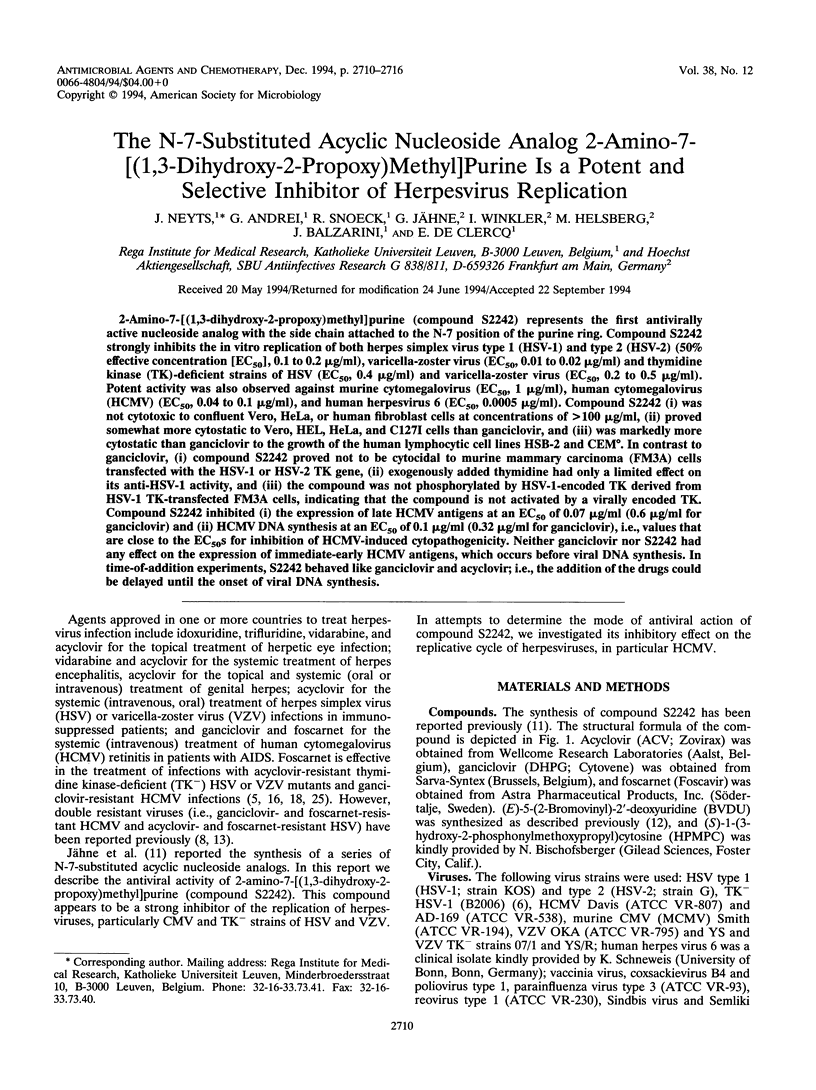
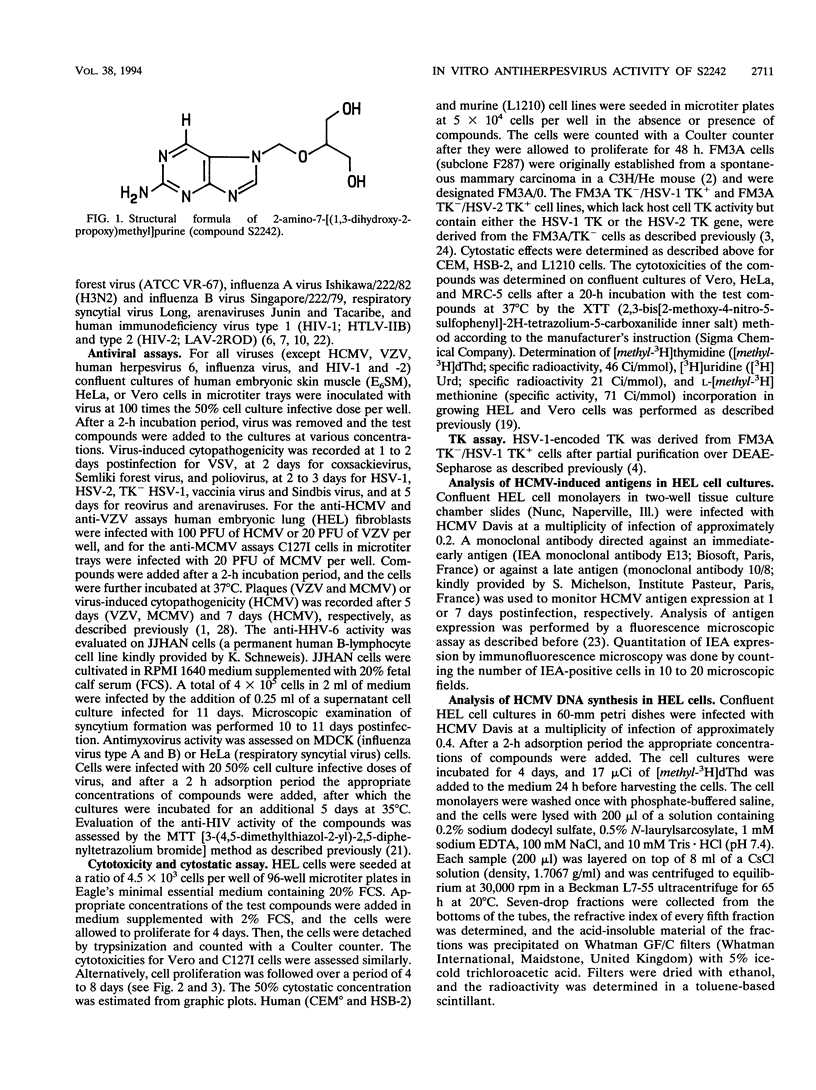
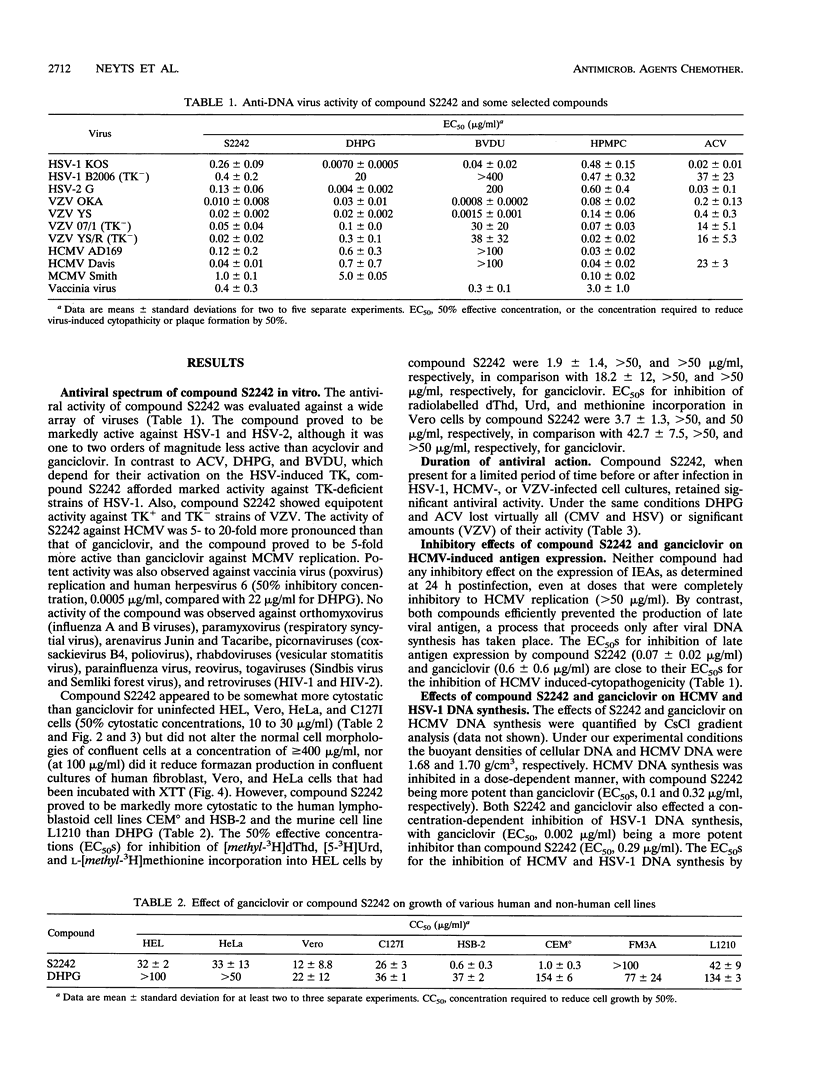
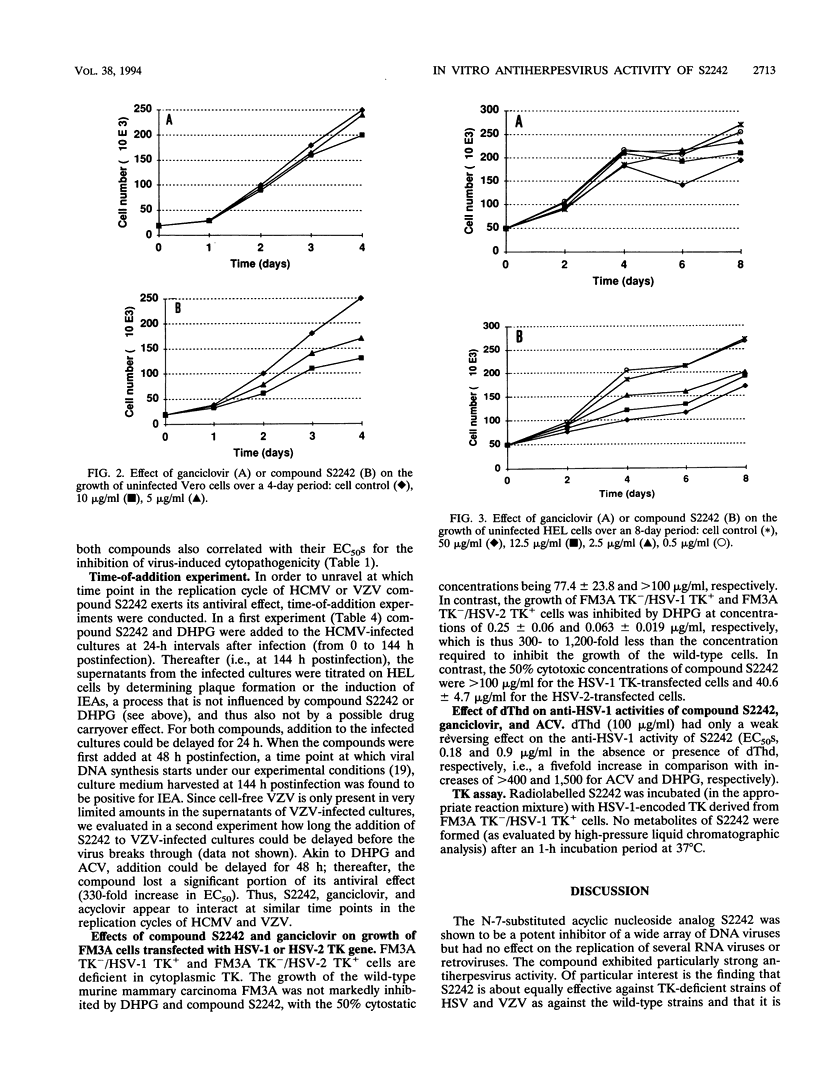
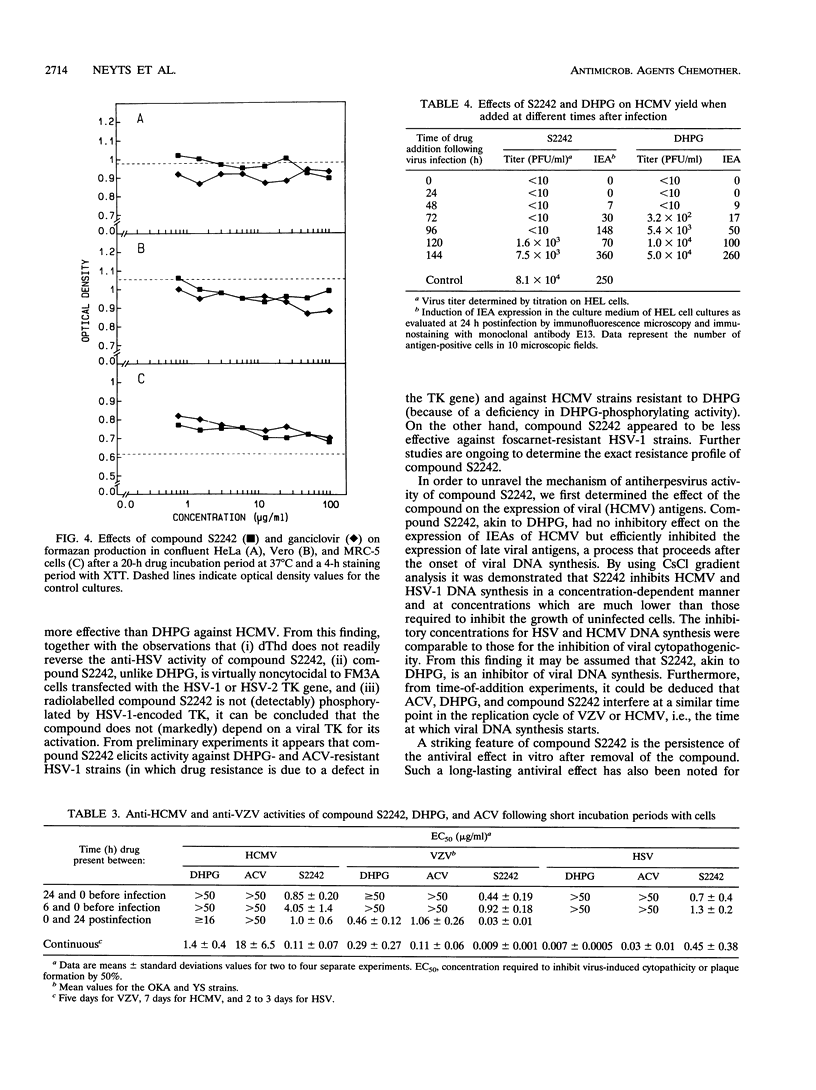
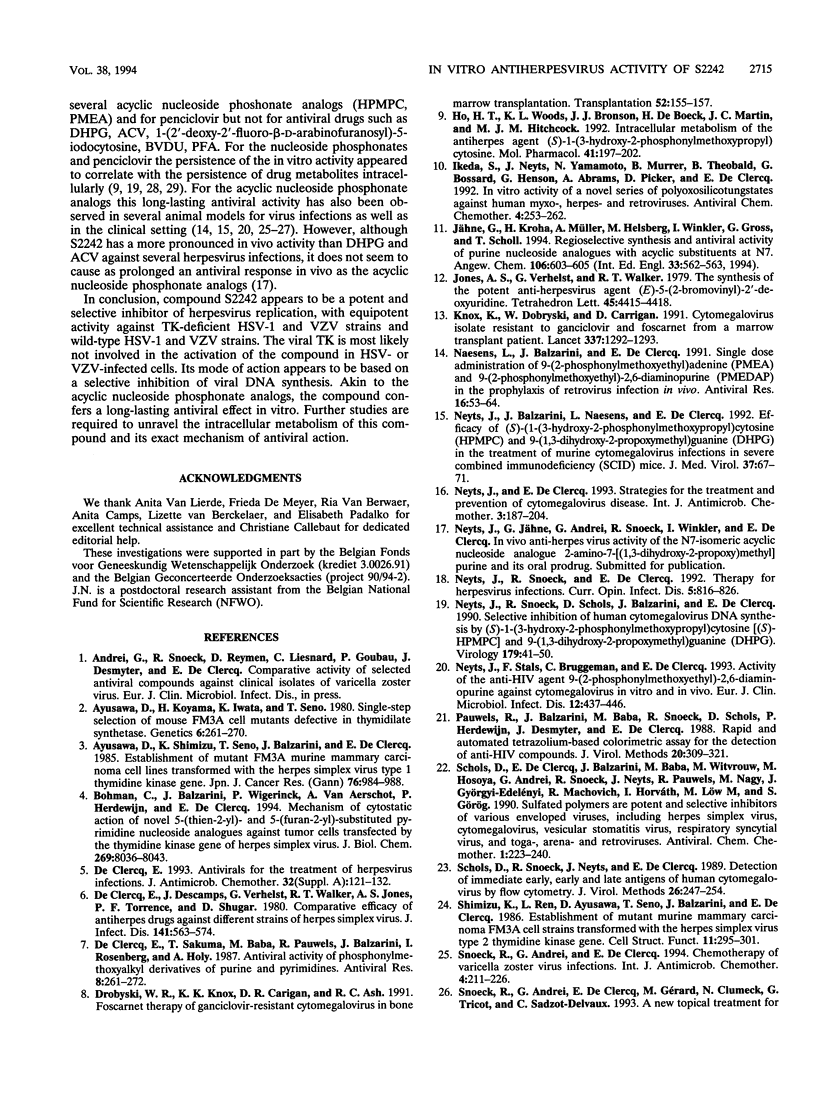
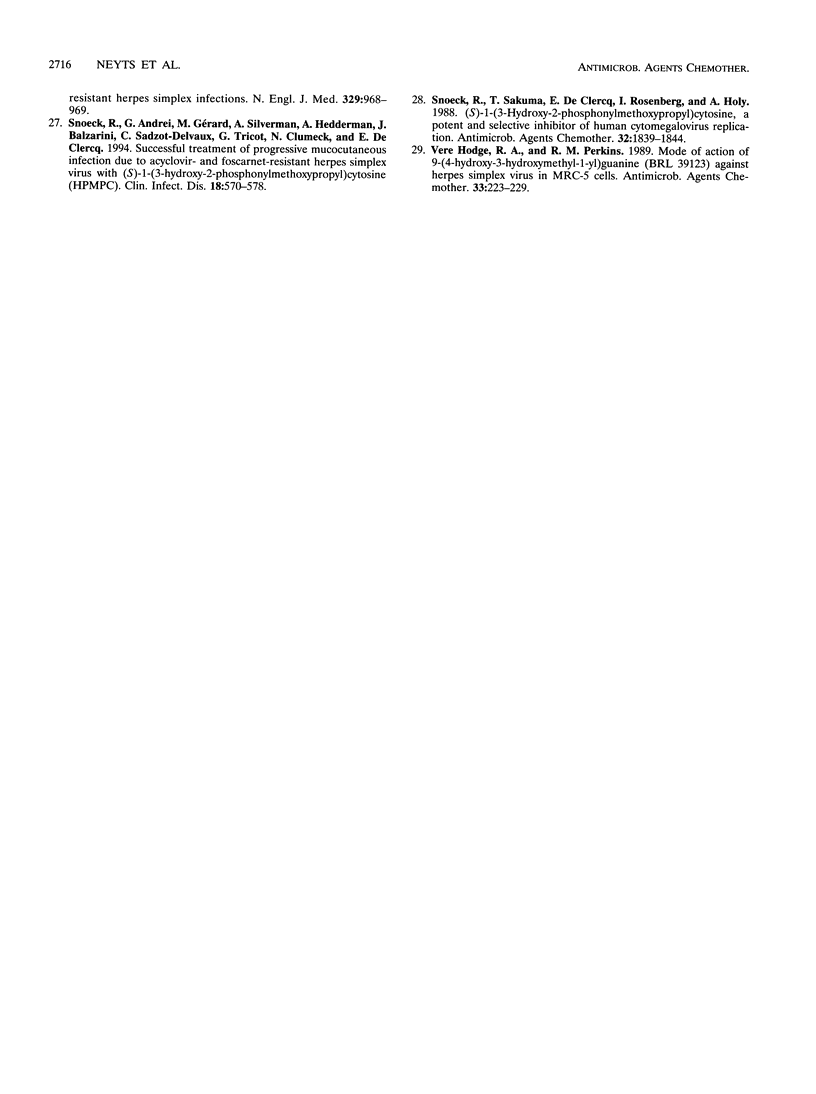
Selected References
These references are in PubMed. This may not be the complete list of references from this article.
- Ayusawa D., Koyama H., Iwata K., Seno T. Single-step selection of mouse FM3A cell mutants defective in thymidylate synthetase. Somatic Cell Genet. 1980 Mar;6(2):261–270. doi: 10.1007/BF01538800. [DOI] [PubMed] [Google Scholar]
- Ayusawa D., Shimizu K., Seno T., Balzarini J., De Clercq E. Establishment of mutant FM3A murine mammary carcinoma cell strains transformed with the herpes simplex virus type 1 thymidine kinase gene. Jpn J Cancer Res. 1985 Oct;76(10):984–988. [PubMed] [Google Scholar]
- Bohman C., Balzarini J., Wigerinck P., Van Aerschot A., Herdewijn P., De Clercq E. Mechanism of cytostatic action of novel 5-(thien-2-yl)- and 5-(furan-2-yl)-substituted pyrimidine nucleoside analogues against tumor cells transfected by the thymidine kinase gene of herpes simplex virus. J Biol Chem. 1994 Mar 18;269(11):8036–8043. [PubMed] [Google Scholar]
- De Clercq E. Antivirals for the treatment of herpesvirus infections. J Antimicrob Chemother. 1993 Jul;32 (Suppl A):121–132. doi: 10.1093/jac/32.suppl_a.121. [DOI] [PubMed] [Google Scholar]
- De Clercq E., Descamps J., Verhelst G., Walker R. T., Jones A. S., Torrence P. F., Shugar D. Comparative efficacy of antiherpes drugs against different strains of herpes simplex virus. J Infect Dis. 1980 May;141(5):563–574. doi: 10.1093/infdis/141.5.563. [DOI] [PubMed] [Google Scholar]
- De Clercq E., Sakuma T., Baba M., Pauwels R., Balzarini J., Rosenberg I., Holý A. Antiviral activity of phosphonylmethoxyalkyl derivatives of purine and pyrimidines. Antiviral Res. 1987 Dec;8(5-6):261–272. doi: 10.1016/s0166-3542(87)80004-9. [DOI] [PubMed] [Google Scholar]
- Drobyski W. R., Knox K. K., Carrigan D. R., Ash R. C. Foscarnet therapy of ganciclovir-resistant cytomegalovirus in marrow transplantation. Transplantation. 1991 Jul;52(1):155–157. [PubMed] [Google Scholar]
- Ho H. T., Woods K. L., Bronson J. J., De Boeck H., Martin J. C., Hitchcock M. J. Intracellular metabolism of the antiherpes agent (S)-1-[3-hydroxy-2-(phosphonylmethoxy)propyl]cytosine. Mol Pharmacol. 1992 Jan;41(1):197–202. [PubMed] [Google Scholar]
- Hodge R. A., Perkins R. M. Mode of action of 9-(4-hydroxy-3-hydroxymethylbut-1-yl)guanine (BRL 39123) against herpes simplex virus in MRC-5 cells. Antimicrob Agents Chemother. 1989 Feb;33(2):223–229. doi: 10.1128/aac.33.2.223. [DOI] [PMC free article] [PubMed] [Google Scholar]
- Knox K. K., Drobyski W. R., Carrigan D. R. Cytomegalovirus isolate resistant to ganciclovir and foscarnet from a marrow transplant patient. Lancet. 1991 May 25;337(8752):1292–1293. doi: 10.1016/0140-6736(91)92965-5. [DOI] [PubMed] [Google Scholar]
- Naesens L., Balzarini J., De Clercq E. Single-dose administration of 9-(2-phosphonylmethoxyethyl)adenine (PMEA) and 9-(2-phosphonylmethoxyethyl)-2,6-diaminopurine (PMEDAP) in the prophylaxis of retrovirus infection in vivo. Antiviral Res. 1991 Jul;16(1):53–64. doi: 10.1016/0166-3542(91)90058-y. [DOI] [PubMed] [Google Scholar]
- Neyts J., Balzarini J., Naesens L., De Clercq E. Efficacy of (S)-1-(3-hydroxy-2-phosphonylmethoxypropyl)cytosine and 9-(1,3-dihydroxy-2-propoxymethyl)guanine for the treatment of murine cytomegalovirus infection in severe combined immunodeficiency mice. J Med Virol. 1992 May;37(1):67–71. doi: 10.1002/jmv.1890370112. [DOI] [PubMed] [Google Scholar]
- Neyts J., Snoeck R., Schols D., Balzarini J., De Clercq E. Selective inhibition of human cytomegalovirus DNA synthesis by (S)-1-(3-hydroxy-2-phosphonylmethoxypropyl)cytosine [(S)-HPMPC] and 9-(1,3-dihydroxy-2-propoxymethyl)guanine (DHPG). Virology. 1990 Nov;179(1):41–50. doi: 10.1016/0042-6822(90)90271-r. [DOI] [PubMed] [Google Scholar]
- Neyts J., Stals F., Bruggeman C., De Clercq E. Activity of the anti-HIV agent 9-(2-phosphonyl-methoxyethyl)-2,6-diaminopurine against cytomegalovirus in vitro and in vivo. Eur J Clin Microbiol Infect Dis. 1993 Jun;12(6):437–446. doi: 10.1007/BF01967438. [DOI] [PubMed] [Google Scholar]
- Pauwels R., Balzarini J., Baba M., Snoeck R., Schols D., Herdewijn P., Desmyter J., De Clercq E. Rapid and automated tetrazolium-based colorimetric assay for the detection of anti-HIV compounds. J Virol Methods. 1988 Aug;20(4):309–321. doi: 10.1016/0166-0934(88)90134-6. [DOI] [PubMed] [Google Scholar]
- Schols D., Snoeck R., Neyts J., de Clercq E. Detection of immediate early, early and late antigens of human cytomegalovirus by flow cytometry. J Virol Methods. 1989 Dec;26(3):247–254. doi: 10.1016/0166-0934(89)90107-9. [DOI] [PubMed] [Google Scholar]
- Shimizu K., Ren L., Ayusawa D., Seno T., Balzarini J., De Clercq E. Establishment of mutant murine mammary carcinoma FM3A cell strains transformed with the herpes simplex virus type 2 thymidine kinase gene. Cell Struct Funct. 1986 Sep;11(3):295–301. doi: 10.1247/csf.11.295. [DOI] [PubMed] [Google Scholar]
- Snoeck R., Andrei G., Gérard M., Silverman A., Hedderman A., Balzarini J., Sadzot-Delvaux C., Tricot G., Clumeck N., De Clercq E. Successful treatment of progressive mucocutaneous infection due to acyclovir- and foscarnet-resistant herpes simplex virus with (S)-1-(3-hydroxy-2-phosphonylmethoxypropyl)cytosine (HPMPC). Clin Infect Dis. 1994 Apr;18(4):570–578. doi: 10.1093/clinids/18.4.570. [DOI] [PubMed] [Google Scholar]
- Snoeck R., Sakuma T., De Clercq E., Rosenberg I., Holy A. (S)-1-(3-hydroxy-2-phosphonylmethoxypropyl)cytosine, a potent and selective inhibitor of human cytomegalovirus replication. Antimicrob Agents Chemother. 1988 Dec;32(12):1839–1844. doi: 10.1128/aac.32.12.1839. [DOI] [PMC free article] [PubMed] [Google Scholar]


